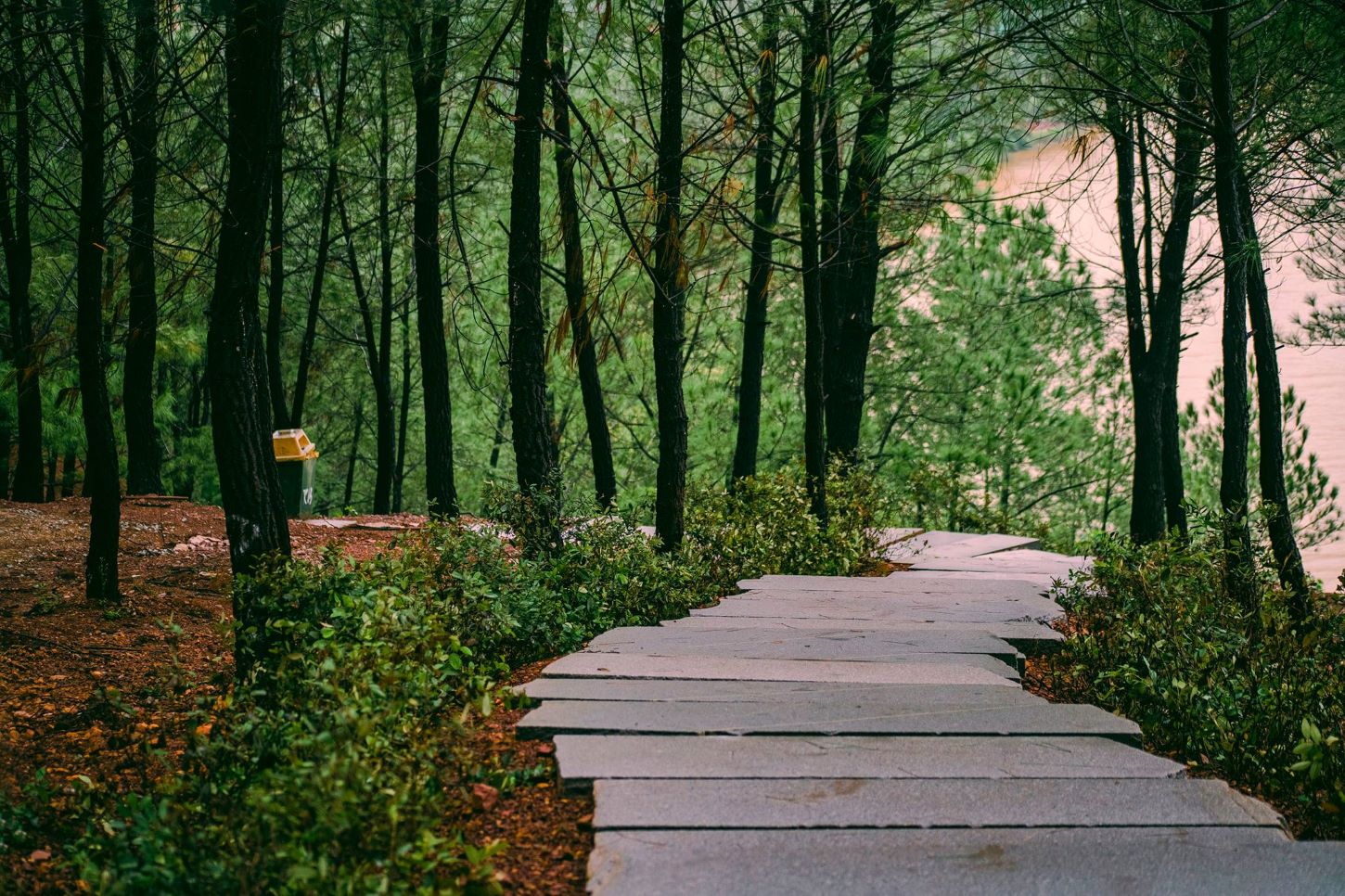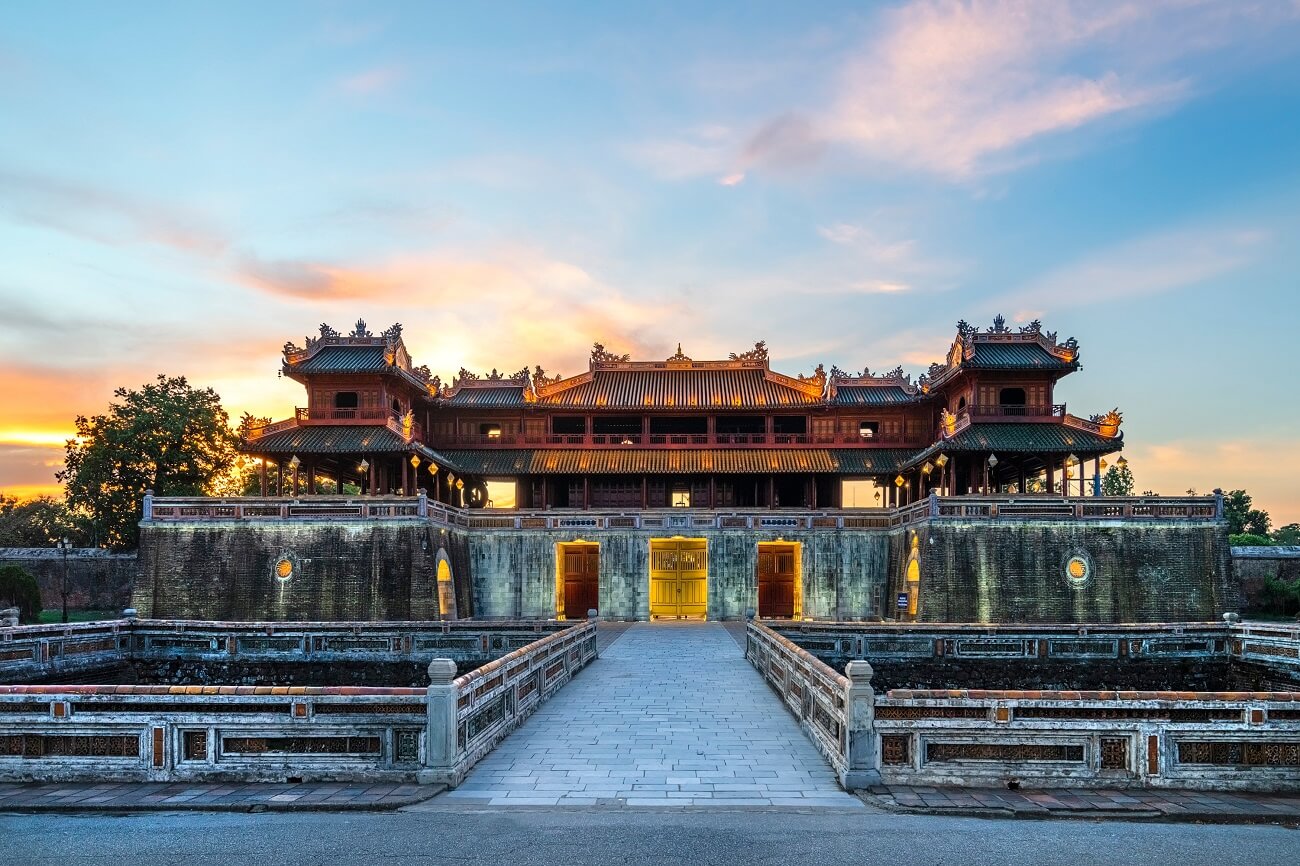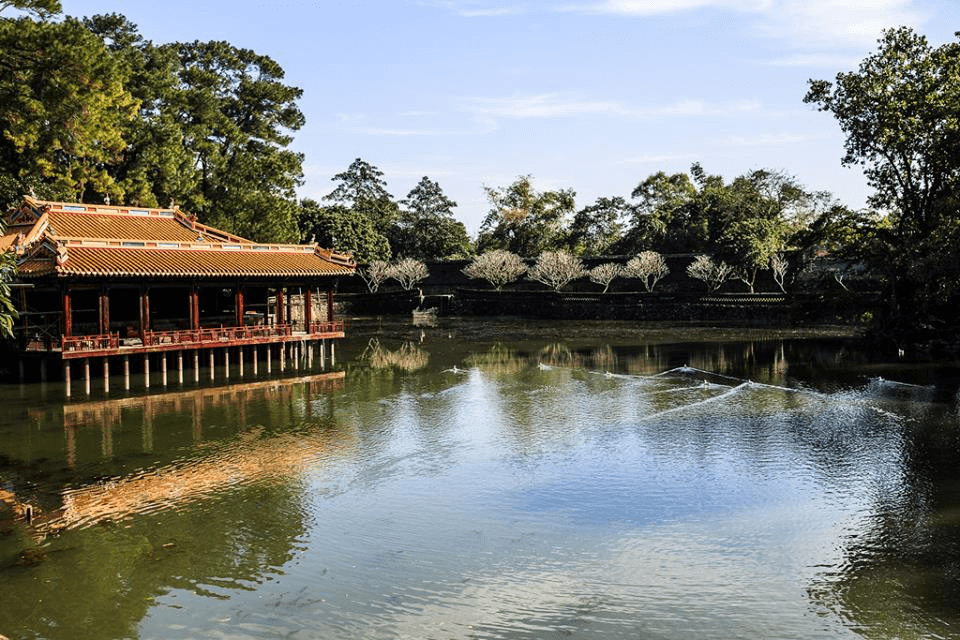In the heart of the ancient capital, Thien Mu Pagoda stands as a timeless symbol, casting its shadow over the romantic Huong River. This ancient temple captivates visitors not only with its ancient architecture but also with its mysterious historical legends. Join Queen Cafe Bus to fully explore this serene beauty!
1. Introduction to Thien Mu Pagoda
Thien Mu Pagoda (also known as Linh Mu Pagoda) is one of the most ancient and sacred pagodas in the ancient capital. Located on Ha Khe Hill, on the left bank of the peaceful Huong River, the pagoda was built in 1601 during the reign of Lord Nguyen Hoang and quickly became a leading cultural, spiritual, and scenic symbol of Hue.
When you visit, you will be immersed in a peaceful atmosphere, listening to the sound of temple bells ringing in harmony with the rustling wind, and exploring the impressive traditional architecture of Thien Mu Pagoda.
- Address: Huong Long Ward, Hue City (on Ha Khe Hill, on the banks of the Huong River).
- Thien Mu Pagoda opening hours: 8:00 a.m. – 6:00 p.m. daily.
- Admission fee to visit Thien Mu Pagoda: FREE.
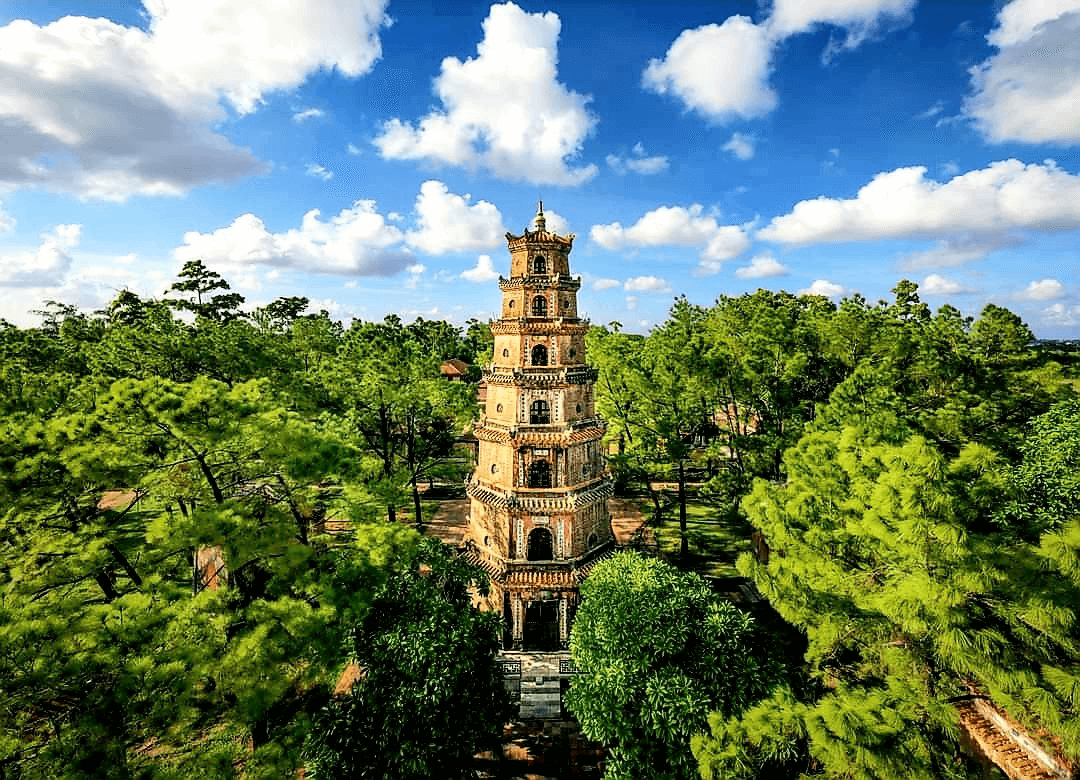
2. Where is Thien Mu Pagoda? Detailed directions to the pagoda
2.2 Tips for traveling to Hue and visiting Thien Mu Pagoda for visitors from afar
For those with a wandering spirit who want to travel to Hue from Hanoi, Da Nang, or Hoi An, Queen Cafe Bus is an excellent choice. You will be able to relax completely in a luxurious limousine with a private cabin. More importantly, the bus will gently take you straight to the center of Hue at 7 Doi Cung, very close to Trang Tien Bridgeso you can relax, check in, and start your journey to explore the dreamy ancient capital of Hue without a care in the world.
To make your trip more complete, please refer to the price list for Queen Cafe Bus's main routes below:
| BUS ROUTE TO HUẾ | PRICE | BOOK TICKETS |
| Hanoi ⇔ Hue | $15.00 – $22.50 | Place it here |
| Da Nang ⇔ Hue | $150 | Place it here |
| Hoi An ⇔ Hue | $150 | Place it here |
| Ninh Binh ⇔ Hue | $150 - $200 | Place it here |
| Quang Binh ⇔ Hue | $180 | Place it here |
📞 For attentive consultation and the fastest ticket booking, you can contact:
- Hotline: 0906.413.468 – 0914.215.809
- Zalo: 0905.746.884 – 0914.215.809
- Website: https://queenbus.com.vn/
- Fanpage: Queen Cafe Open Bus
2.1 How to get to Thien Mu Pagoda from Hue city center
From the city center, you can easily reach Thien Mu Pagoda by various means of transportation. Below are the most popular options:
2.1.1 Motorcycle / Car
This is the ideal vehicle for those who love the freedom to explore and want to be in control of their time.
- Suggested itinerary: From the center (Le Loi Street) → turn onto Bui Thi Xuan Street → cross Da Vien Bridge → continue straight on Kim Long Street for about 2 km until you reach Thien Mu Pagoda on your left.

2.1.2 Dragon Boat on the Perfume River
A poetic experience, allowing you to admire the majestic temple from the river. This is a wonderful way to fully appreciate the beauty of the temple in its natural setting.
- Starting point: The Khâm Palace Boat Landing.
2.1.3 Taxi / Ride-hailing
Quick and cool choice, especially suitable when traveling in a group or with family members including elderly people and children.
- Suggestion: You can experience the smooth and environmentally friendly Xanh SM electric taxi.
3. The History and Mysterious Legends of Thien Mu Pagoda
Thien Mu Pagoda is not only famous for its beauty but also for its rich history spanning over 400 years, along with colorful legends and anecdotes that add to the sacred and mysterious aura of this ancient temple. Visitors to Thien Mu Pagoda should not miss these stories.
3.1. The Legend of Thien Mu Pagoda: The Prophecy of the Old Woman in Red
Few people know that the name Thien Mu Pagoda is linked to a very special legend. Legend has it that, since ancient times, local people often saw an old woman wearing a red shirt and green pants appear on the top of Ha Khe Hill (where the pagoda is located today).
The old woman often prophesied that, in the future, a "true lord" would come to this land to build a temple, help gather the dragon's energy, and strengthen the southern waterways. Immediately after making her prediction, the old woman disappeared mysteriously. From then on, this hill was called Thien Mu Mountain, and the story became the sacred legend of Thien Mu Temple, which has been passed down to this day.
When Lord Nguyễn Hoàng arrived to take up his post in Thuận Hóa, he heard this story and immediately set out by boat upstream. Perfume River To find out. Upon arriving at Ha Khe Hill, seeing that the land was extremely beautiful, just as the prophecy had said, the lord decided to build a pagoda in 1601 and named it Linh Mu Pagoda (the original name of the pagoda, meaning "Sacred Mother").

3.2. The story of King Tu Duc renaming the temple "Linh Mu"
Another interesting anecdote related to the temple's name originates from King Tu Duc. It is said that King Tu Duc was highly skilled in literature and poetry but had no heir. He believed that the character "Thiên" (Heaven) in the name "Thiên Mụ" was an offense to heaven, and also carried a meaning related to childbirth (Mụ means midwife), which could affect his destiny.
Therefore, in 1862, to avoid taboos and pray for children, King Tu Duc issued a decree changing the name "Thien Mu Temple" to "Linh Mu Temple." This name is still used today, and both names are recognized.
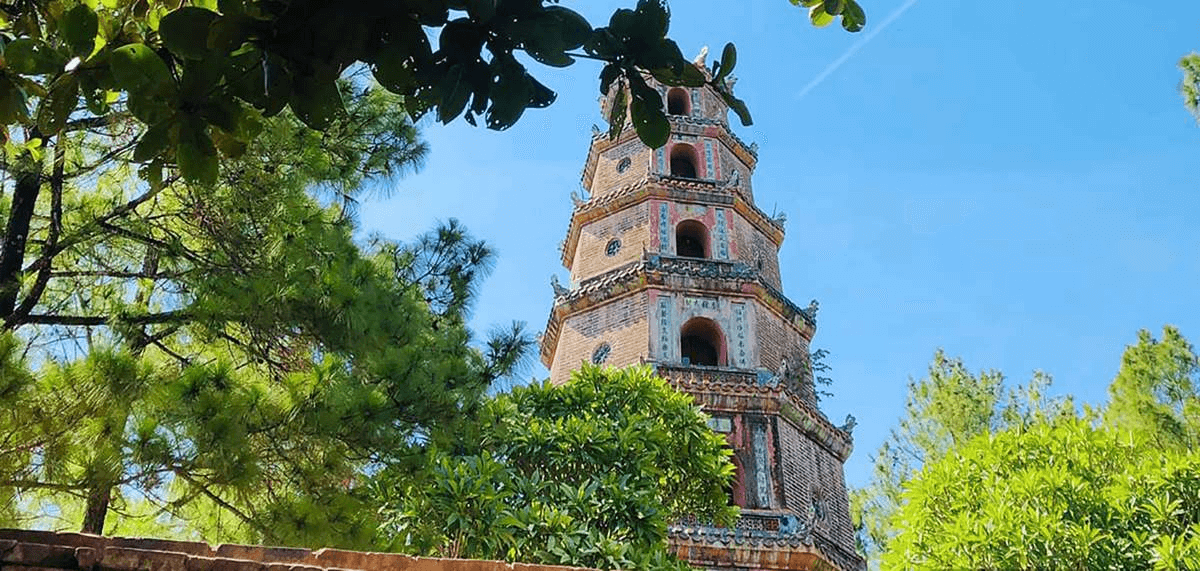
3.3. "The Curse of Love" at Thien Mu Pagoda – Fact or Fiction?
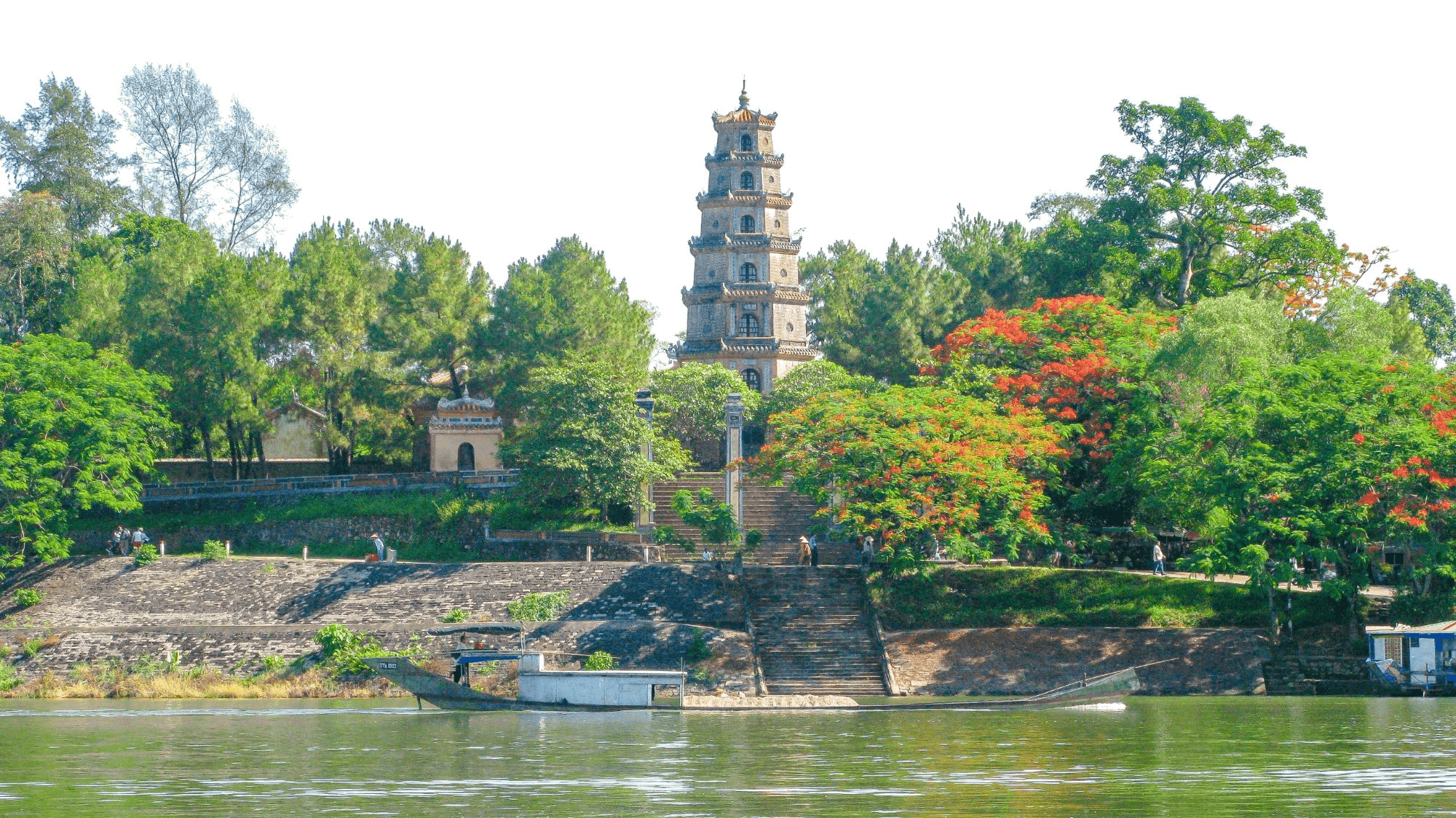
Perhaps one of the most intriguing things about Thien Mu Pagoda is its famous "love curse." Legend has it that if couples in love visit Thien Mu Pagoda together to burn incense and make a wish, their love will soon fall apart. This tragic story is often associated with the unfulfilled love of a young couple who loved each other deeply but were forbidden by their families. They came to the pagoda together to make a vow, then threw themselves into the Huong River to be together forever. From then on, rumors of separation began to spread.
What is the truth? From a cultural and spiritual perspective, this is probably just a folk legend, a cautionary tale about the bonds of destiny and fate. Many couples have visited Thien Mu Pagoda and still enjoy lasting happiness. The true meaning of visiting the pagoda is to find peace and tranquility, and to pray for peace for oneself and one's family.
Whether love lasts or not depends on the nurturing and understanding of both people, not on any "curse." So, don't hesitate to explore the ancient and sacred beauty of the temple with your loved one!
4. Explore the architectural structures in Thien Mu Pagoda
Nestled beside the romantic Huong River, Thien Mu Pagoda makes a strong impression with its imposing traditional architecture and grounds shaped like a giant turtle carrying the ancient temple.
The architecture of Thien Mu Pagoda is harmoniously arranged into two distinct areas, imbued with cultural and historical value.
4.1. Phuoc Duyen Tower
One cannot fail to mention the Phuoc Duyen Tower of Thien Mu Pagoda, the most prominent and recognizable symbol of Thien Mu Pagoda. Built in 1844 during the reign of King Thieu Tri, the tower stands an impressive 21 meters tall with seven majestic floors, soaring skyward. Each floor of the tower houses a Buddha statue, and inside there is a spiral staircase leading to the top floor, where a precious golden Buddha statue once stood.
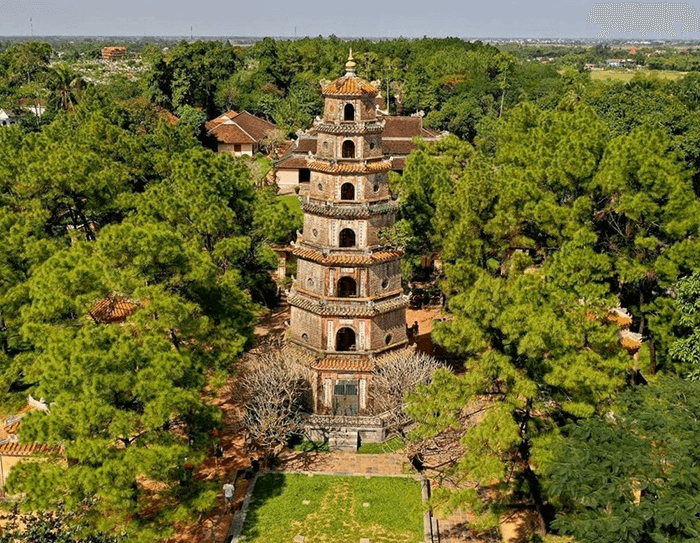
The skillfully arranged flat-bent copper windows allow natural light to gently fill the tower, creating a space that is both mysterious and tranquil. From the top floor of the tower (if accessible), visitors can take in the poetic view of the winding Huong River and the distant Truong Son mountain range, creating a picturesque landscape. On either side of the tower are the stele house and bell tower, which house the Dai Hong Chung bell with its unique patterns, bearing the mark of ancient artistry.
4.2. The Three-Gate Pavilion and the wooden Guardian Deity statues
Nghi Mon Gate – also known as the Three-Gate Entrance to Thien Mu Pagoda – is a unique two-story architectural structure with eight curved roofs, embodying the distinctive architectural style of the imperial court of Hue. Passing through the Three-Gate Entrance, you will be able to admire 12 exquisitely crafted and majestic wooden sculptures.
These are the statues of the Guardian Deities and Vajrapani, arranged symmetrically on both sides. Each statue exudes courage and majesty with meticulous, sharp carvings, symbolizing the guardian deities of this sacred place, leaving you in awe of the talent of the ancient artisans.
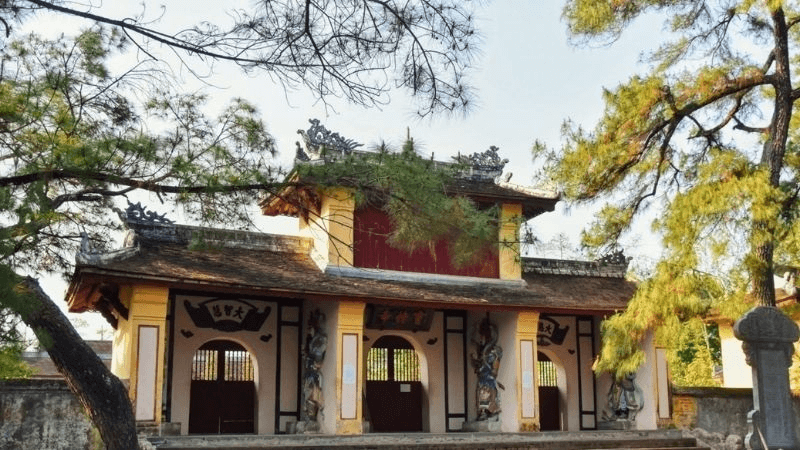
4.3. Dai Hung Power Plant
The Dai Hung Hall is the most majestic and solemn main hall of Thien Mu Pagoda. Upon entering the hall, you will immediately feel the atmosphere of tranquility and meditation. Inside the hall, there is a bronze statue of Maitreya Buddha along with many other precious statues and an ancient bronze bell cast in 1677.
In particular, this place also preserves a lacquered and gilded horizontal plaque inscribed by Lord Nguyễn Phúc Chu in 1714, adding profound historical and spiritual value to this sacred space.

4.4. Other important structures on campus
The grounds of Thien Mu Pagoda are spacious and harmoniously blend natural surroundings with ancient architecture, creating an indescribable sense of tranquility and sacredness. The entire pagoda is divided into two main areas, each featuring structures of distinctive architectural and historical value:
- The area in front of the Nghi Mon Gate: Includes a boat dock with 24 steps leading up from the river, a three-gate entrance with four pillars, and the Huong Nguyen Pavilion – where the Austin car of the late Venerable Thich Quang Duc is currently on display. Behind the pavilion is the Phước Duyên tower – the symbol of the pagoda, 21 meters high with seven floors enshrining Buddha statues and the top floor housing a golden Buddha statue. On either side of the pavilion are two square stele towers and set back are two hexagonal towers – one for hanging bells and one for storing precious stone steles from the Nguyễn dynasty.
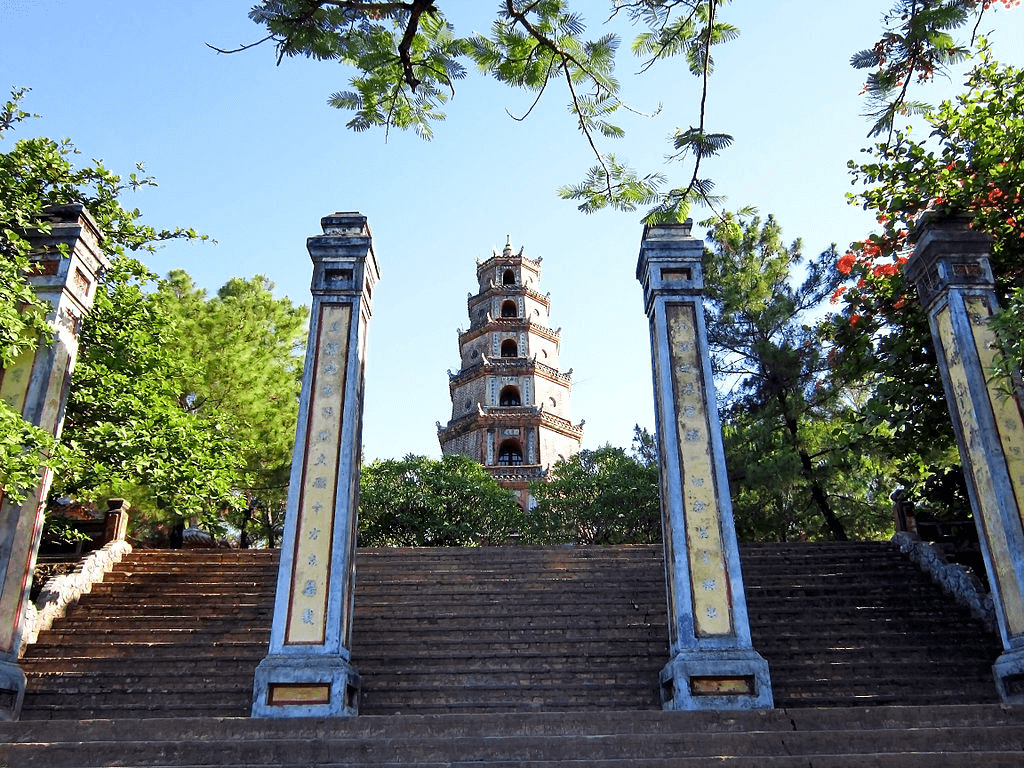
- The area inside the Nghi Mon Gate: The complex features important spiritual structures such as the Grand Temple—a solemn main hall dedicated to Buddha—along with the Earth Store Temple, the Avalokitesvara Temple, the Trai House, the Guest House, the flower garden, and the tranquil pine forest behind. Together, they create a serene, ancient space imbued with Zen spirit for visitors and Buddhists who come to explore and worship.
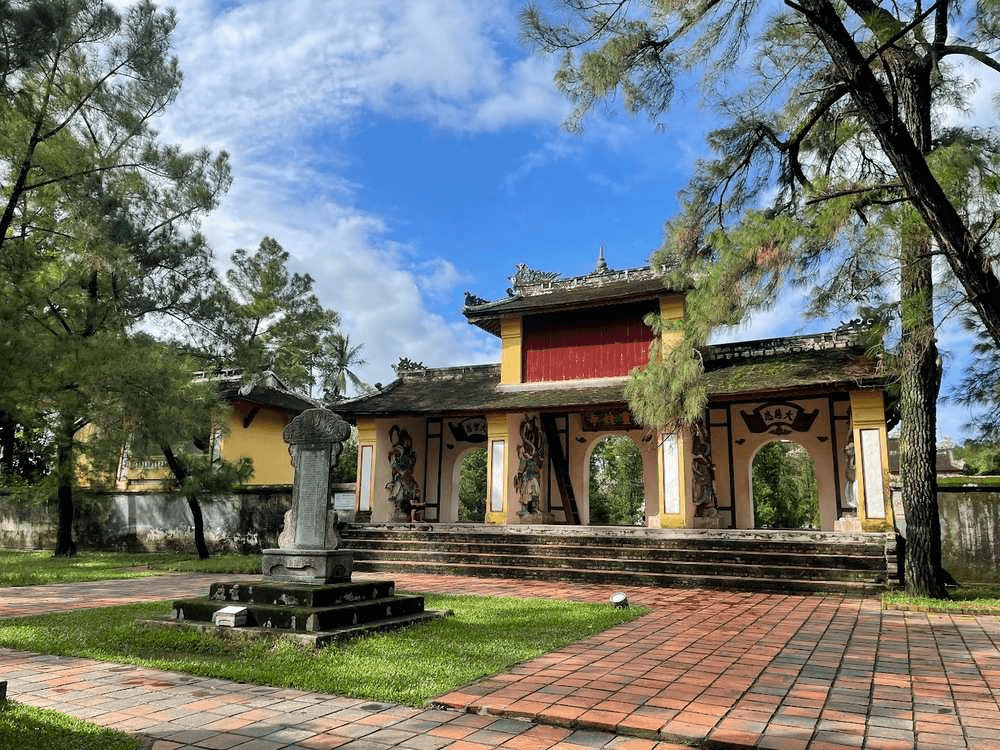
4.5. Tomb of the late Venerable Thich Don Hau
Located within the quiet grounds of the temple, the tomb of the late Venerable Thích Đôn Hậu is a destination of profound historical and spiritual significance. Venerable Thích Đôn Hậu was a learned monk and one of the most important Buddhist leaders in Vietnam in the 20th century.
He made significant contributions to the revival of Buddhism, the protection of Thien Mu Pagoda, and became a symbol of resilience in the movement for peace. The tomb tower is designed simply yet solemnly, reflecting the respect for the venerable monk, and is a place where visitors can come to pay their respects and worship.
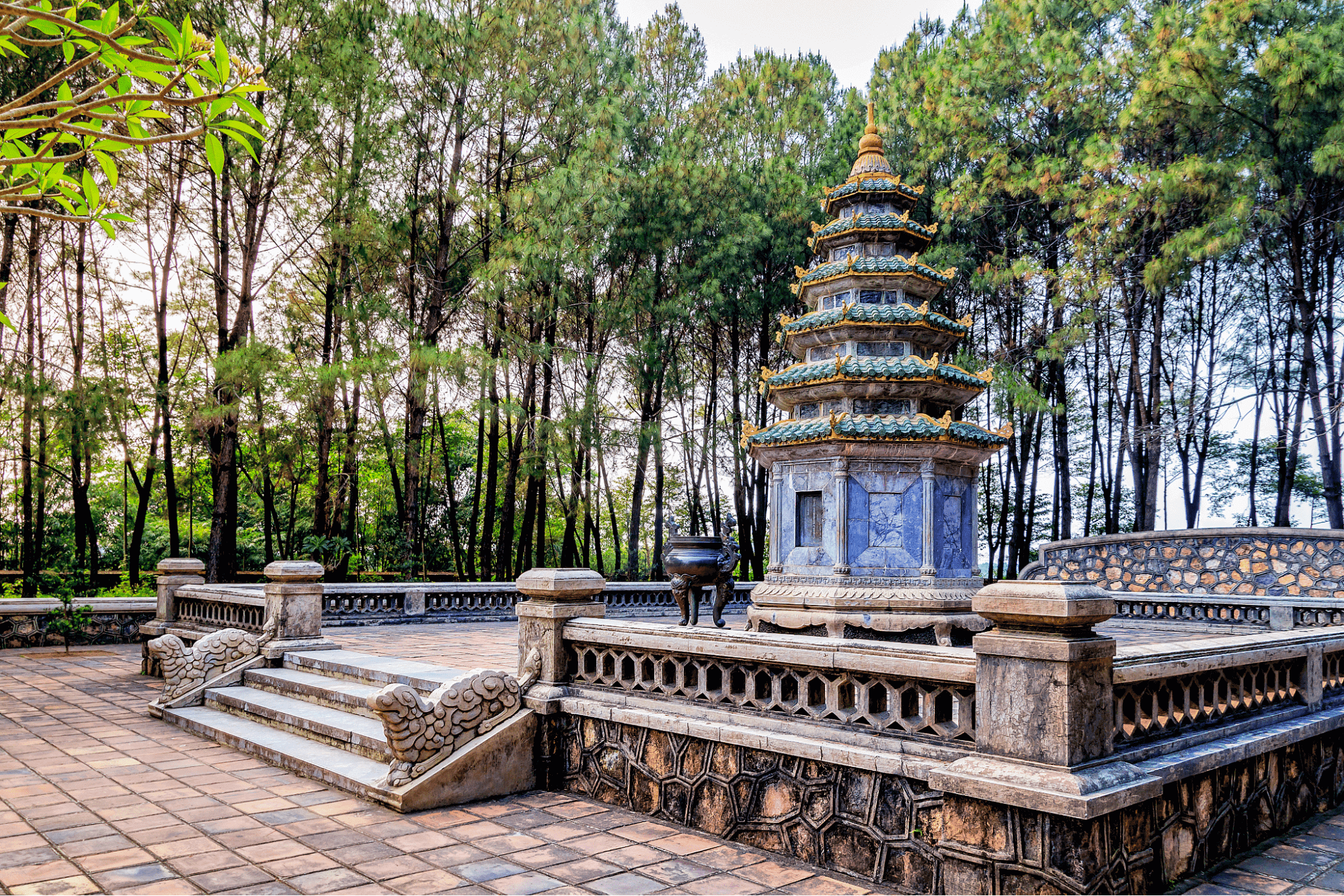
5. The priceless treasures and special relics at Thien Mu Pagoda
Thien Mu Pagoda attracts visitors not only for its architecture but also for its priceless treasures and special relics, which attest to the pagoda's rich history and spiritual significance.
5.1. The Great Bell – The "Soul" of Thien Mu Pagoda
One of the temple's most precious treasures is the Great Red Bell. Cast in 1710 during the reign of Lord Nguyễn Phúc Chu, this bell stands an impressive 2.5 meters tall and weighs over 2 tons.
What is even more special is that the bell is engraved with an inscription written by Lord Nguyen Phuc Chu himself, praising the beauty of the pagoda and Buddhist philosophy. The deep, resonant sound of the Dai Hong Chung bell is considered the "soul" of the pagoda, echoing endlessly along the Huong River, creating a space of meditation and peace characteristic of Hue.

5.2. The Austin Car – A Historical Relic of Bodhisattva Thich Quang Duc
After the Great Hero Temple, you will find a moving historical relic: the blue Austin car. This is the very car that transported Venerable Thich Quang Duc from Hue to Saigon in 1963 to carry out his self-immolation protest against the Ngô Đình Diệm regime's suppression of Buddhism.
This vehicle is not only a means of transportation but also a vivid testament to the country's turbulent historical period, symbolizing the indomitable spirit of Vietnamese Buddhism. Viewing this vehicle evokes deep emotions and reflections on a heroic chapter in the nation's history.

6. The complete guide to visiting Thien Mu Pagoda that you can't miss
6.1. When is the best time to visit Thien Mu Pagoda to take beautiful photos?
Each season, each moment, Thien Mu Pagoda has its own unique beauty. For the best experiences and photos, consider the following times:
- Spring (January – February): The weather is pleasant. The weather in Hue is currently cool and dry, ideal for leisurely strolls and sightseeing. The soft light of spring also provides the perfect conditions for beautiful, pure photos.
- Summer (May–June): The vibrant colors of the flamboyant tree Visiting the temple in summer, you will be able to admire rows of bright red flamboyant trees blooming along the river. The vivid colors of the flowers reflect on the Huong River, creating an impressive and romantic picture of the ancient capital.
- Sunset Moment: A Beauty Not to Be Missed This is probably the most beautiful and peaceful time at the temple. As the sun sets, the golden afternoon light covers the scenery, making the ancient temple even more serene and poetic. Listening to the temple bells ringing in that quiet space is an indescribably peaceful experience, helping you deeply feel the soul of Hue.
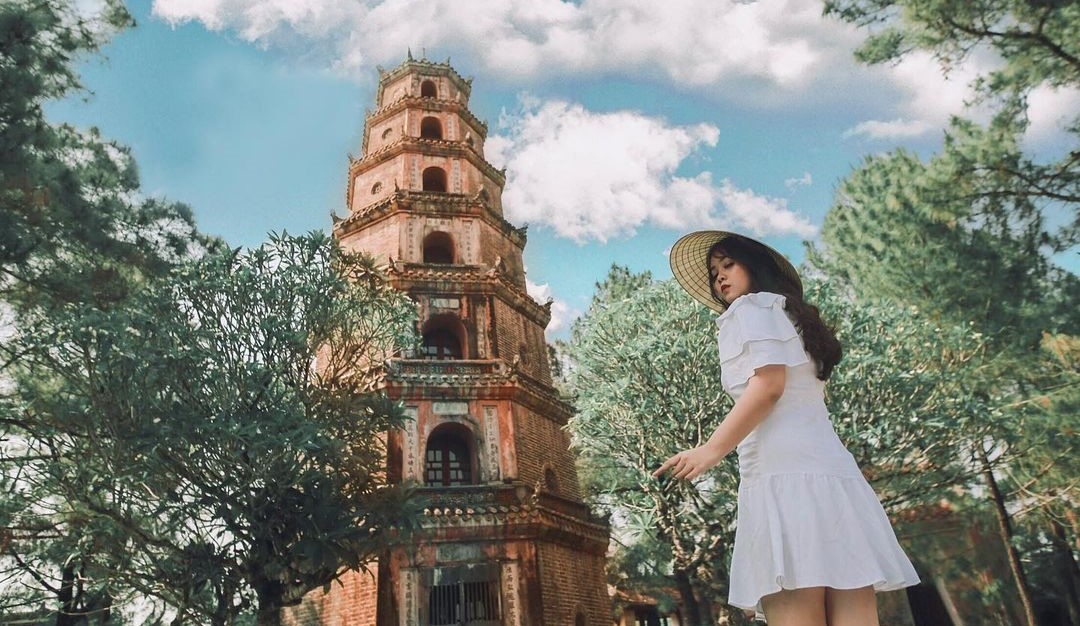
6.2. Picturesque "check-in" spots and sunset views at Thien Mu Pagoda
Thien Mu Pagoda is a paradise for "living virtually" with countless unique photo spots. Get your camera ready and explore these picturesque locations:
- Stairs down to the boat dock: From here, you can take in the majestic view of Phuoc Duyen Pagoda and the romantic Huong River, especially at sunset.
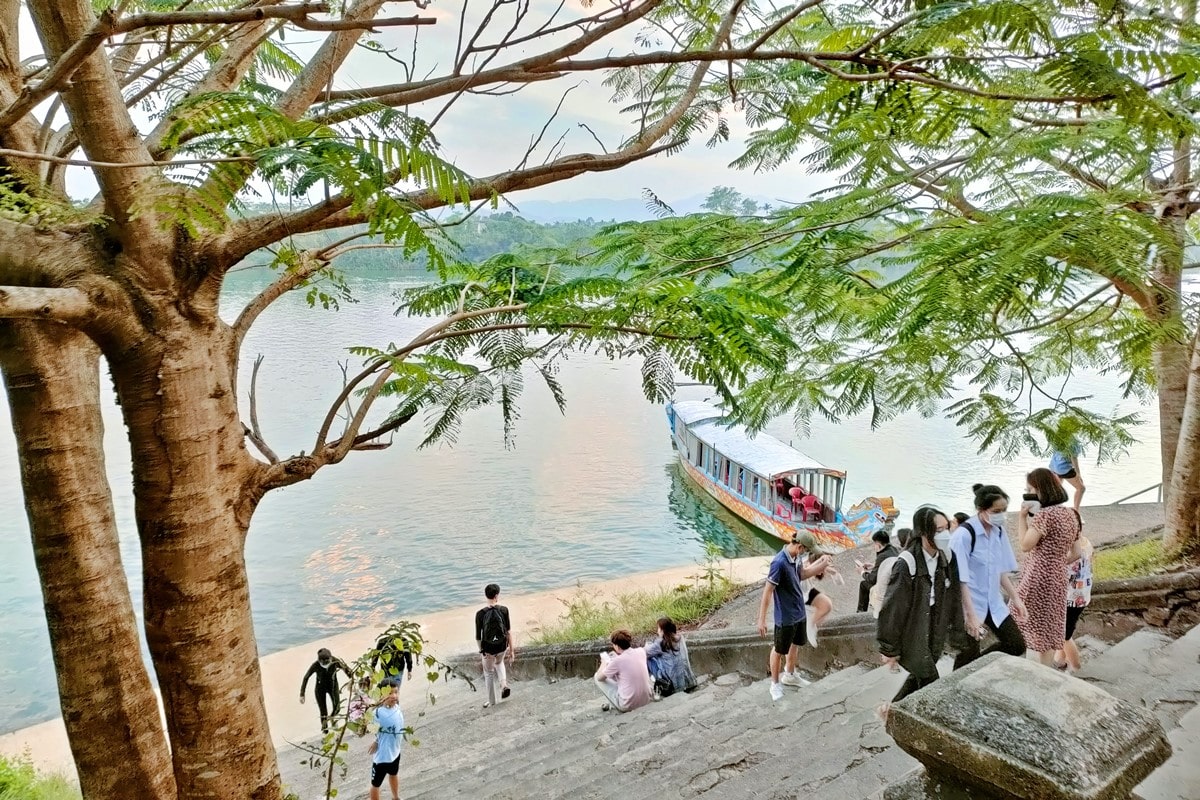
- Next to Phuoc Duyen Tower: Standing next to the temple's symbol, you'll get impressive check-in photos that clearly show the tower's ancient and majestic appearance.

- Ha Khe Hill Campus: The lush green garden and ancient stone paths provide the perfect backdrop for deep, Zen-inspired photos.

- A distant view from the Huong River: If you take a boat trip, don't forget to capture the temple's full panorama from the middle of the river. You will see a breathtakingly beautiful view of Thien Mu Pagoda in Hue.

Final words
Thien Mu Pagoda is not only an architectural heritage but also the soul of the ancient capital, where time seems to stand still beside the Huong River. To make your journey to this peaceful place truly complete, let Queen Cafe Bus accompany you. With our comfortable and convenient buses, we will take you to Hue in a relaxed manner, ready for an inspiring start to explore the ancient temple and the endless beauty of the ancient capital.
Frequently Asked Questions
Phuoc Duyen Tower: A majestic 7-storey tower, 21 meters high.
Dai Hong Bell: A giant ancient bronze bell.
Prime Location: Situated on Ha Khe Hill, overlooking the poetic Perfume River.

